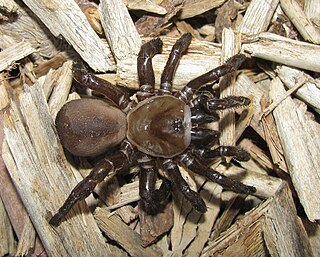
Idiopidae, also known as armored trapdoor spiders, is a family of mygalomorph spiders first described by Eugène Simon in 1889. They have a large body similar to tarantulas.

Barychelidae, also known as brushed trapdoor spiders, is a spider family with about 300 species in 42 genera. Most spiders in this family build trapdoor burrows. For example, the 20 millimetres (0.79 in) long Sipalolasma builds its burrow in rotted wood, with a hinged trapdoor at each end. The 10 millimetres (0.39 in) long Idioctis builds its burrow approximately 5 centimetres (2.0 in) deep, just below the high tide level, sealing the opening with a thin trapdoor.

Migidae, also known as tree trapdoor spiders, is a family of spiders with about 100 species in eleven genera. They are small to large spiders with little to no hair and build burrows with a trapdoor. Some species live in tree fern stems. They have a Gondwanan distribution, found almost exclusively on the Southern Hemisphere, occurring in South America, Africa, Madagascar, Australia, New Zealand and New Caledonia.

Pamphobeteus is a genus of tarantulas native to northwestern South America: Colombia, Ecuador, Peru, Bolivia and Brazil. It includes some of the largest spiders in the world. Pamphobeteus was first believed to be a member of the genus Lasidora, but was later distinguished by the lack of scopulae on the inferior side of the first leg femur and the differences in the organ for stridulation.

Psalmopoeus is a genus of the family Theraphosidae containing various species of tarantulas. The genus is native to Central America and South America including the West Indies. These species are believed to be relatively venomous, and research in the venom of P. cambridgei shows it to be similar to capsaicin, the molecule causing irritation in chili peppers. These molecules activate sensory cells to send pain signals to the brain. Genetic engineers are working on blocking the receptors that are activated by these molecules.
Eucyrtops is a genus of Australian armored trapdoor spiders that was first described by Reginald Innes Pocock in 1897. As of May 2019 it contains only two species: E. eremaeus and E. latior.
Heligmomerus is a genus of armored trapdoor spiders that was first described by Eugène Louis Simon in 1892.

Scelidomachus socotranus is a species of spider found on the island of Socotra in the Indian Ocean. It is the only member of its genus.
Batesiella is a spider genus in the family Theraphosidae (tarantulas), with the sole species Batesiella crinita. It is native to Cameroon. The genus was named by Reginald Innes Pocock in 1903, and honours the collector, G. L. Bates.

Monocentropus is a genus of spiders in the family Theraphosidae.
Harpactira is a genus of spider in the family Theraphosidae (tarantulas), found in southern Africa.
Tafana is a genus of South American anyphaenid sac spiders first described by Eugène Simon in 1903.
Sasonichus is a monotypic genus of Asian brushed trapdoor spiders containing the single species, Sasonichus sullivani. It was first described by Reginald Innes Pocock in 1900, and has only been found in India. The species Sipalolasma arthrapophysis was briefly placed here before being moved to Sipalolasma in 1985.
Tigidia is a genus of brushed trapdoor spiders first described by Eugène Simon in 1892.
Allothele is a genus of African curtain web spiders that was first described by R. W. E. Tucker in 1920.

Paramigas is a genus of tree trapdoor spiders native to Madagascar. It was first described by Reginald Innes Pocock in 1895.
Spiroctenus is a genus of spiders in the Nemesiidae family. It was first described in 1889 by Simon. As of 2017, it contains 30 species, all from South Africa.
Aethriscus is a genus of Central African orb-weaver spiders first described by Reginald Innes Pocock in 1902. As of April 2019 it contains only two species, both found in Middle Africa.

Halonoproctidae is a family of mygalomorph spiders, split off from the family Ctenizidae in 2018. Species in the family are widely distributed in North and Central America, Australasia, Asia, southern Europe and North Africa. One species is recorded from Venezuela in South America. They are relatively large, sombrely coloured spiders, that live in burrows with some kind of trapdoor.









